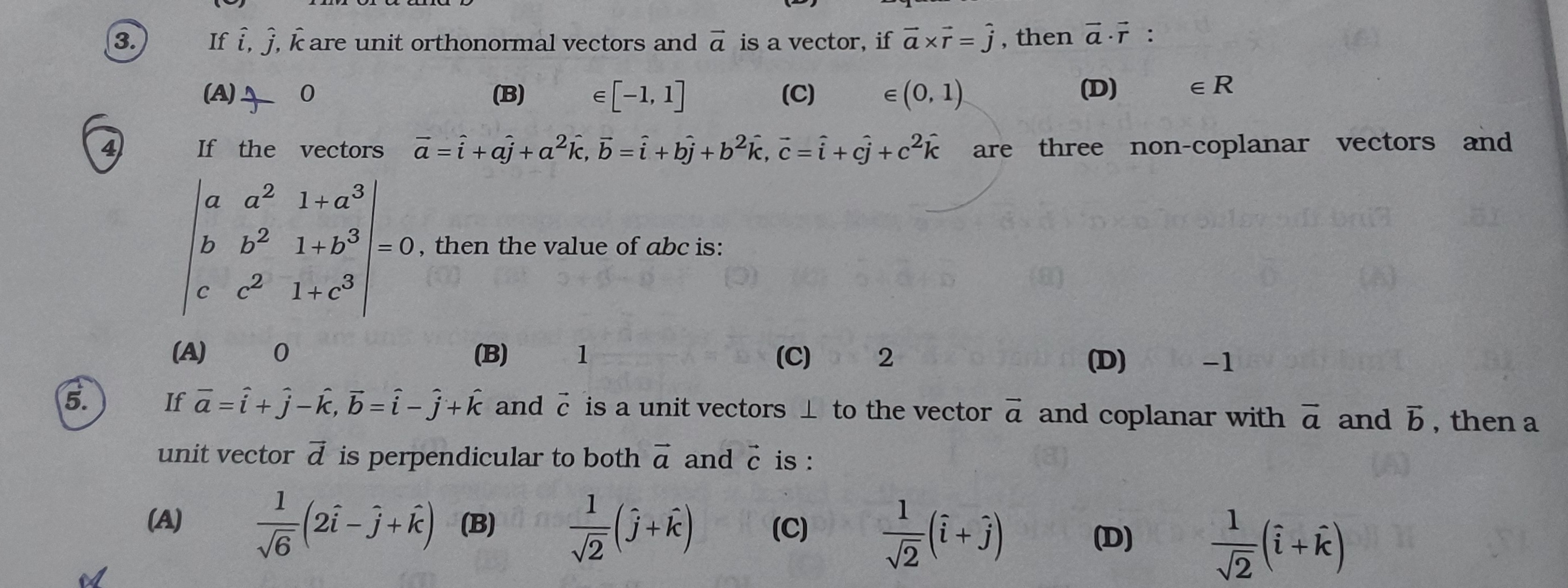Question
Question: If $\hat{i}$, $\hat{j}$, $\hat{k}$ are unit orthonormal vectors and $\bar{a}$ is a vector, if $\bar{...
If i^, j^, k^ are unit orthonormal vectors and aˉ is a vector, if aˉ×rˉ=j^, then aˉ⋅rˉ :

0
∈[−1,1]
∈(0,1)
∈R
(D)
Solution
Given the equation aˉ×rˉ=j^. This implies that j^ is perpendicular to both aˉ and rˉ. Therefore, aˉ⋅j^=0 and rˉ⋅j^=0.
Let aˉ=a1i^+a2j^+a3k^ and rˉ=r1i^+r2j^+r3k^. From aˉ⋅j^=0, we get a2=0. So, aˉ=a1i^+a3k^. From rˉ⋅j^=0, we get r2=0. So, rˉ=r1i^+r3k^.
Now, let's compute the cross product aˉ×rˉ: aˉ×rˉ=(a1i^+a3k^)×(r1i^+r3k^) aˉ×rˉ=a1r1(i^×i^)+a1r3(i^×k^)+a3r1(k^×i^)+a3r3(k^×k^) Using i^×i^=k^×k^=0, i^×k^=−j^, and k^×i^=j^: aˉ×rˉ=a1r3(−j^)+a3r1(j^)=(a3r1−a1r3)j^ We are given aˉ×rˉ=j^. Thus, (a3r1−a1r3)j^=1j^ This implies a3r1−a1r3=1.
Now, let's compute the dot product aˉ⋅rˉ: aˉ⋅rˉ=(a1i^+a3k^)⋅(r1i^+r3k^) aˉ⋅rˉ=a1r1(i^⋅i^)+a1r3(i^⋅k^)+a3r1(k^⋅i^)+a3r3(k^⋅k^) Using i^⋅i^=k^⋅k^=1 and i^⋅k^=k^⋅i^=0: aˉ⋅rˉ=a1r1(1)+a1r3(0)+a3r1(0)+a3r3(1)=a1r1+a3r3 We have the condition a3r1−a1r3=1. We need to determine the possible values of a1r1+a3r3.
Let's test with specific vectors. Choose aˉ=i^. Then a1=1,a3=0. The condition a3r1−a1r3=1 becomes 0⋅r1−1⋅r3=1, which means r3=−1. The vector rˉ must be of the form rˉ=r1i^−k^ (since r2=0). Then, aˉ⋅rˉ=i^⋅(r1i^−k^)=r1(i^⋅i^)−(i^⋅k^)=r1(1)−0=r1. Since r1 can be any real number, aˉ⋅rˉ can take any real value.
